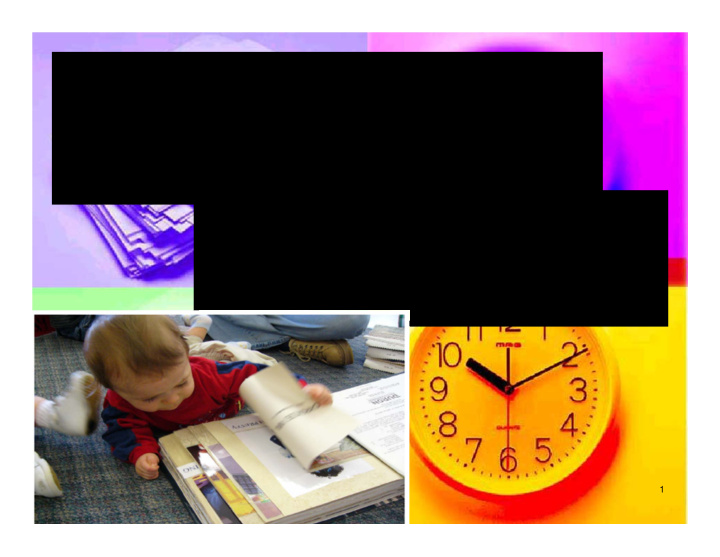



Lullabies to Literacy: Early Literacy Development Patsy Pierce, Ph.D. Research Division, NCGA Early Childhood Education Improvement Committee February 2, 2012 1
National Early Literacy Panel (NELP) Synthesis of: • all high-quality scientific research that identified preschool and kindergarten skills that predict later reading 2
NELP Findings • Found Three Highly-Significant Predictors: – Oral Language – Alphabetic Code/Phonological Awareness – Print Knowledge/Concepts 3
Oral and Written Language Connections Develop concurrently; Assist in each system’s development; Share the same basic sound system (phonemes); Share the same basic rule system (morphemes and syntax) 4
Oral and Written Language Speaking/AAC Reading Writing Listening 5
National Findings: Literacy Skills “ Fab Five”: K-3 “ Thrilling Three”: B-K Oral language Phonemic awareness Alphabetic code print Phonics Knowledge/concepts Vocabulary Fluency Comprehension National Institute of Child Health National Center for Family and Human Development Literacy (2005). National (NICHD). (2000). Report of the early literacy panel: national reading panel. Teaching children to read: An Synthesizing the evidence-based assessment of scientific research on the scientific research literature development of early on reading and its implications literacy in young children. for reading instructions. Reports of the subgroups. Washington, DC: Author. 6
5 Interventions NELP identified 5 categories of interventions that we can use to promote early literacy development: – Code-related interventions – Shared reading interventions – Language enhancement interventions – Parent and home programs for improving children’s literacy – Preschool and kindergarten programs 7
Intentional ABC & Phonological Awareness Activities Supports for Emergent Reading/Writing Play-based, contextual experiences Rich Oral Language Environment Ongoing Assessment Family Involvement 8 Teaching Strategies
Comprehension Fluency Vocabulary Phonics Phonemic Awareness Outcomes 9
O Comprehension U T C Fluency O M Vocabulary E S S Phonics Intentional Alphabet/Phonological T Awareness Activities R Supports for A Emergent Reading/Writing T E Rich Oral Language Environments, Play- G based Activities I Ongoing Assessment E 10 Family Involvement S
Family Involvement Literacy resources (e.g., library cards, books, literacy education for families); Children’s literacy workshops for families, based on their needs and interests; Family members reading to children in classrooms, sending in taped readings reflective of cultural and linguistic backgrounds. 11
Ongoing Assessment Informs practice Uses multiple, authentic approaches – Observation Notes – Work Samples 12
How does ______________write his name? (Motor & Cognitive item) 13 Item from The Bridge Early Language and Literacy Portfolio Framework
Item 6.1 14
Item 6.3 15
Rich Oral Language Environment Children talk more than adults ALL children have multiple ways to communicate Adults really listen-show true interest in what children are doing and saying Reflect on what children are doing; use encouragement rather than praise Label their feelings Ask open-ended, action questions; give suggestions Encourage choice & rule making Have real conversations with each child everyday Use a variety of words. Help children learn at least 2 new words everyday 16 Literacy-rich curricula: S.L. 2011-145,Section 10.7(b)
Literacy-rich water play 17
Supports for Emergent Reading Story Sharing Environmental Print (e.g., logos, newspapers, magazines) Print in the environment (e.g., labels, books, directions, dictation) Book Sharing – ACIRI – Follow the C*A*R* (comment and wait; ask questions and wait, respond by adding a little more – www.walearningsystems.org Shared Reading of Big Books Dialogic Reading (CROWD) Modeling Use of Reading for Real Purposes (e.g., learning, problem solving, task completion) Information books, ABC books, story books in centers Literacy-rich curricula: S.L. 2011-145,Section 10.7(b) See provided list 18
Reading daily schedule 19
Supports for Emergent Writing Language Experience Approach Shared Writing Modeling use of writing for real purposes (e.g., memory, self- expression, ownership) Writing props Sign in 20
Supports for Writing Development=People, Pencils, Paper, Purpose 21
Guided alphabet and phonological awareness activities Point out letter in Singing, rhyming, child’s name while and alliteration reading and/or (e.g., chore charts, looking at word walls) environmental print Segmenting of ( have ABC books names for in centers) transition activity Play with letter names and letter sounds throughout the day (sign in, word walls, letter walks). 22
Talking about letters in names 23
24
ABC’s Everywhere! Mailboxes 25
26
Recommend
More recommend